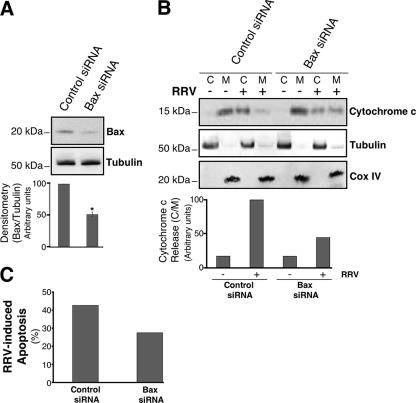FIG. 6.
Cytochrome c release induced by RRV infection of MA104 cells is Bax dependent. (A) Knockdown of Bax expression in MA104 cells. (Top) Cells were transfected with a specific Bax siRNA or an irrelevant siRNA. Bax protein was then assayed in whole-cell lysates by immunoblotting. Levels of tubulin were used as protein loading controls. Positions of molecular weight markers are indicated on the left. (Bottom) Bax protein levels were determined by densitometry and plotted as ratios relative to the levels of tubulin. The graph shows the mean percentage of Bax expression inhibition from three independent experiments. Error bars, standard errors of the means. *, P < 0.05 by a Student t test comparing irrelevant-siRNA-transfected to Bax siRNA-transfected MA104 cells. (B) siRNA-induced silencing of the Bax gene results in a reduction of RRV-induced cytochrome c release in MA104 cells. (Top) Cells were infected with RRV 48 h posttransfection, and cytochrome c was analyzed in cytosolic (C) and heavy-membrane (M) fractions by Western blotting 14 h p.i. Mock-infected MA104 cells were used as negative controls. Tubulin and Cox IV were used as controls for the protein loading of the C and M fractions, respectively. Positions of molecular weight markers are indicated on the left. (Bottom) Cytochrome c protein levels of M and C fractions were determined by densitometry and plotted as ratios relative to the levels of Cox IV and tubulin, respectively. (C) siRNA-induced silencing of the Bax gene results in a reduction of RRV-induced apoptosis in MA104 cells. Cells were infected with RRV 48 h posttransfection, and the percentage of apoptosis was determined by flow cytometry after AO staining. MA104 cells transfected with an irrelevant siRNA were used as negative controls.

